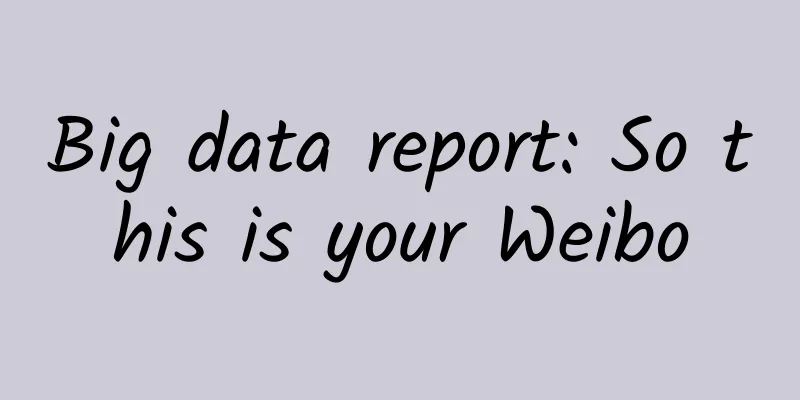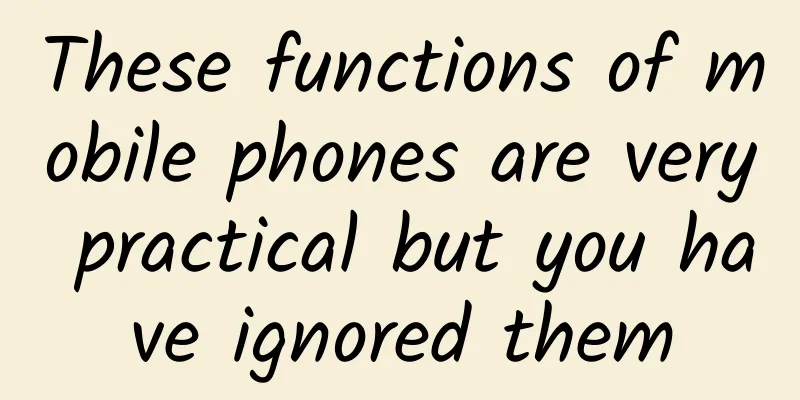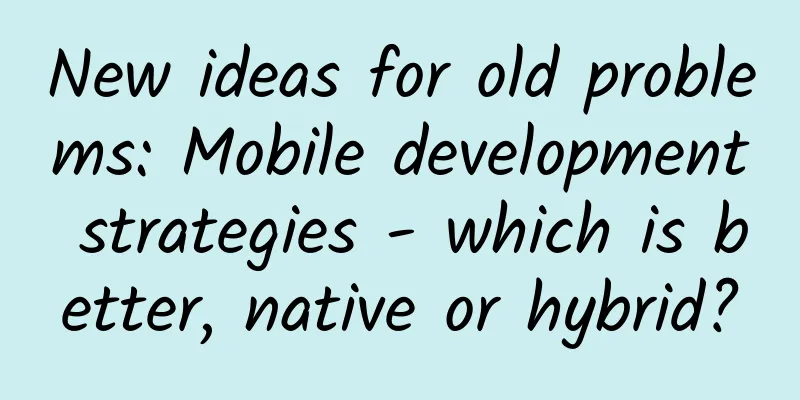Big data report: So this is your Weibo

|
(This report is about 4,200 words and takes about 15-18 minutes to read in depth. We think it is worth it and therefore recommend it to you) This may be a rare story in the history of China's Internet, a story of returning to the top after experiencing peaks and troughs. After experiencing rapid development and a round of pessimism, Sina Weibo, as one of the representatives of Chinese social networks, has once again become the focus of industry attention through a series of outstanding achievements. Compared with the products of the previous microblog boom, today's microblog has almost become an all-encompassing super community. Some users choose to leave, and new users join. Regarding the relationship between Weibo and its users today, perhaps the following questions are more important and direct: How does Weibo's user stickiness compare to other information apps? What are the characteristics of Weibo’s loyal users, new users, and churned users? Which content format do users prefer most? How many users have left Weibo and moved to other social media? What is the value of Weibo in the minds of users? In order to answer the above questions, Penguin Intelligence conducted a survey on Weibo usage behavior and value cognition among 8,373 netizens nationwide, and made precise sampling according to the characteristics of Chinese netizens. We hope to explore the opportunities and challenges hidden behind the rise of Weibo through the user behavior and psychology of Weibo today. Core Summary of the Report 1. Among Weibo's loyal users and new users, women and those born in the 1990s and 2000s account for a higher proportion, while among Weibo's lost users, men with high knowledge account for a higher proportion; 2. The average daily usage time of Weibo and Zhihu is almost consistent; 3. 40% of WeChat and Weibo users spend more time reading Weibo; 4. Forced following of unfamiliar accounts is a pain point for 90% of existing users; 5. Pictures, texts and short videos are the most eye-catching content formats; 6. 31.2% of Weibo users have engaged in consumption activities related to Weibo. The overall penetration rate of Weibo payment is about 9%. Purchasing Weibo recommended products and rewarding articles rank high among Weibo consumption behaviors. 7. The driving effect of Weibo red envelopes on consumption and payment is not obvious. Among the respondents who have "grabbed Weibo red envelopes", the proportion of other Weibo payments and consumption is about 38.6%, which is 7.4% higher than the overall penetration rate of Weibo consumption. The following is the report text: A. Weibo's History and Today The 2016Q2 financial report shows that Weibo's net revenue and number of active users continue to grow, and its penetration rate in third- and fourth-tier cities has further increased. The financial report also mentioned the significant growth of Weibo's short video business, with the number of views in Q2 reaching 1.57 billion. Although the strategic cooperation between Weibo and Alibaba was terminated in January 2016, advertising revenue was not affected. Weibo's advertising product matrix has gradually become richer, and advertising accounted for 85.3% of Weibo's net revenue in Q2. In terms of the average daily usage time per person per month, Weibo users spent an average of 26.2 minutes on Weibo per day in July 2016, a slight increase compared to 2015. Weibo user stickiness is far behind WeChat and QQ, and also behind personalized information applications Jinri Toutiao and Yidian Zixun. Except for being briefly surpassed by live broadcast application Inke in December 2015 and January 2016, Weibo's stickiness is higher than Huajiao and Inke. Interestingly, compared with other applications listed in the table above, the average daily usage time of Weibo and Zhihu is almost consistent. Perhaps it is because Weibo is easy to form popular topics, and these hot topics are more likely to become questions and discussion materials in the question-and-answer community Zhihu. This bond may indirectly affect the activity of Zhihu users. B. New Weibo user profile: Why do they leave and why do they come back? Among the mobile Internet users who participated in the survey, 71.7% have used Weibo. We will focus on three types of users: loyal users (31.2%), new users (11.6%) and lost users (28.9%). According to the survey data, the proportion of lost Weibo users is higher than the proportion of new users. Combined with the data disclosed in Weibo’s financial report showing the growth of MAU, one possible scenario is that the activity of Weibo’s existing users has increased significantly, compensating for and reversing the impact of lost users (Note: the data on lost and new users comes from Penguin Intelligence Research, for reference only, and does not represent official Weibo data). B1. Loyal users: Hot events and celebrities are the most attractive Following hot topics is the main demand of Weibo loyal users, accounting for 73.5%. The second is celebrities, accounting for 47.2%. Socializing is not the main demand, accounting for only 14.4%. Among loyal users, the proportion of female users is nearly 10% higher than that of male users, and those born in the 1990s (including those born in the 2000s) account for the largest age group. B2. Lost users: The main reason is the shift of attention of high-knowledge users The primary reason for users to leave Weibo is that their attention is diverted to other social media, accounting for 43.7%. The second is disappointment in content and product experience, such as lack of valuable content (37.1%), too many advertisements (31.6%), and too many and too complicated functions (22.5%). The survey found that 93.9% of Weibo users who lost their Weibo accounts now use WeChat, 18.6% use interest-based information such as Toutiao, and 11.7% use Zhihu. This reflects that WeChat and interest-based information, which have both social and media functions, have a certain degree of substitution for Weibo. Among the lost users, male users, users with a monthly salary of more than 8,000 yuan, and users with a bachelor's degree or above account for a higher proportion. These users generally have higher demands for the value of content and product experience. B3. New users: come for topics of interest, people they follow and hot topics Interest topics and people to follow are effective in attracting new users, and are one of the reasons why more than 40% of new users use Weibo. In contrast, new features such as live streaming are not very effective in attracting new users. The survey found that among the new users, there are slightly more females than males, and the proportion of those born in the 1990s and 2000s is also significantly higher than that of other age groups. Weibo is more attractive to female and young users, probably because they pay more attention to celebrities. B4. Weibo and WeChat dual users: WeChat wins in terms of total volume, while Weibo has the advantage in media attributes For dual users of WeChat and Weibo, those who spend more time on WeChat are 15% more likely to spend more time on Weibo. Those who spend more time on WeChat mainly focus on the two social functions of chatting and Moments. 41.3% of people spend the most time on Weibo, while only 8.5% spend the most time on WeChat public accounts. In terms of obtaining general information, Weibo has a clear advantage. C. Weibo user experience: painful and joyful C1. Forced to follow unfamiliar accounts is a pain point for 90% of existing users After several revisions, Weibo has become more aggressive in attracting traffic. Many Weibo users have encountered the situation of "forcibly following a certain account". So what is the actual effect? The survey shows that only 12.3% of users will click on the accounts they follow out of curiosity. Some of these users will continue to follow, which is a successful group of traffic. The attitude of most other users is disgust: 14.5% of users said they might stop using Weibo because of this, which is a potential loss of customers. More than 70% of users will cancel the objects they are forced to follow. In general, users are more disgusted than willing to be forced to follow, but their tolerance is still very high. There is a game between business and product here. The number of users who leave (14.5%) is close to the number of users who create business effects (12.3%), which may be a support point for short-term decision-making. But in the long run, if the product experience cannot be improved, users who are in a state of tolerance may be further lost. C2. User attention: stars + interests + news 63.1% of users follow celebrities on Weibo, which is the most irreplaceable feature of Weibo compared to other social media - users are unprecedentedly "close" to celebrities. The second most popular category is life interests and news media, which means that users' demand for interest-based information on Weibo exceeds that for timely news. 31.8% of users follow acquaintances on Weibo, which is significantly lower than the first three categories. Internet celebrities also have a 30% follow rate. Users' attention is clearly directed towards interest information rather than social interaction. C3. The most eye-catching content format: pictures, texts and short videos As many as 81.5% of Weibo users like text and picture Weibo the most, followed by short videos and animated pictures, accounting for 59.6% and 40.8% respectively. Long articles are slightly more attractive than pure text, and live broadcasts are the least attractive, attracting only 10.4%. Today's Weibo content is diverse. If someone once compared Weibo to Twitter, now it is more like a huge complex. The potential of short videos is gradually emerging, and entertainment-oriented animated pictures are also very popular. Live broadcasting may not be the most eye-catching, and it is not located at the first-level entrance, but if we consider the user base and usage time of Weibo based on the 10.4% attraction, it can still bring good drainage effect to live broadcasting. The second quarter financial report shows that the average daily number of live broadcast viewers in June was 7.73 million, and the average daily viewing time was 387,000 hours. D. The value of Weibo: media attributes are still the foundation D1. The media value of Weibo From the perspective of content providers, Weibo's media value lies in the fact that it has become a regular channel for publishing various types of information. Among them are serious news, entertainment gossip, and self-media that are deeply engaged in various vertical segments. These big accounts monopolize most of the traffic, but this does not prevent some ordinary users from speaking out on Weibo and attracting public attention. This situation is more common in some livelihood issues that are easy to arouse social concern. Take the girl and Yi Hotel incident as an example. Weibo played the role of a fermentation place for hot events in this incident, and the subsequent Weibo public relations also made the incident last longer on Weibo. From the perspective of content acquirers, 21% of users consider Weibo as the first choice for obtaining news and information, and 64.9% of users consider it as the first/second choice. Nearly 40% of users recognize the diversified perspectives of Weibo information. Weibo can not only meet the basic needs of obtaining news and information, but also provide readers with more diverse perspectives. It satisfies users' demands for the media. D2. Commercial value of Weibo 31.2% of Weibo users have engaged in consumption behaviors related to Weibo. The overall penetration rate of Weibo payment is about 9%, and purchasing Weibo recommended products and rewarding articles rank high among Weibo consumption behaviors. We also investigated the role of Weibo red envelopes in driving consumption. Among the respondents who have "grabbed Weibo red envelopes", the proportion of other Weibo payments and consumption is about 38.6%, which is 7.4% higher than the overall penetration rate of Weibo consumption. Advertising contributes the largest proportion to Weibo's revenue. Although some users think that advertising damages the experience, overall, 51.5% of users do not mind the form of advertising and will not reject it if they encounter products they are interested in. This reflects that consumers have a certain demand for personalized and accurate push advertising. Among other types of advertisements, users prefer celebrity recommendations and interactive promotional ads. D3. Social value: more interactions, weak connections 62% of users basically do not contribute original content, focusing on interaction and forwarding. 35% of users both browse and produce content on Weibo. Interaction and forwarding behaviors mean that many Weibo users are more willing to spread content rather than produce content, and these users cannot bring high-quality UGC. Weibo's social value is weaker than its media value, but the dissemination and interaction of content is based on weak connections between groups with similar interests and celebrities. Combined with the previous survey results, users follow celebrities, information and news accounts the most, and about 30% follow acquaintances' accounts. Therefore, compared with WeChat, Weibo focuses more on weak connection social interaction between strangers - interactive social interaction based on interest information. E. Risks and opportunities of Weibo 【Three major risks】 Loss of high-end users: According to user research, most of Weibo's new users are female and those born after 1990, and their stickiness is also higher. However, the loss of highly educated male users is a risk for Weibo. Imbalance between commercialization and user experience: Overly aggressive traffic diversion, such as forced following, will damage the user experience and lead to user loss. Some users may tolerate and get used to it, but disappointment and discomfort will accelerate the decline of user experience. Weibo should make a new round of trade-offs between commercialization and user experience as soon as possible. Substitutability: Although 64.9% of users consider Weibo as the first/second channel for obtaining news information, 36% of users still think that Weibo is "an occasional pastime that is dispensable." With the rise of personalized information recommendation applications, personalized interest information is no longer scarce. Whether Weibo's content can retain users in the era of content competition is a potential risk. 【Four major opportunities】 Public opinion field with deep user participation: Weibo has high media value for both content providers and acquirers. Local governments and institutions can collect public opinions in a more down-to-earth manner through Weibo, and users from all over the country can also "report" things around them and participate in public welfare activities through Weibo, thereby bringing derived social value. Paid reading: Long articles are slightly more attractive than text-only microblogs. Some users already give rewards, which can further encourage the production of high-quality content and guide content payment. Content layout of short videos and live broadcasts: seize the dividends of short videos and live broadcasts to increase user stickiness, and then retain users and generate new profit opportunities by building high-quality content IP. There is still room for improvement in advertising revenue: the richness of content also means the diversity of advertising formats. Native advertising, celebrity recommendations, and personalized recommendations may become marketing methods that users are more willing to accept. As a winner of Toutiao's Qingyun Plan and Baijiahao's Bai+ Plan, the 2019 Baidu Digital Author of the Year, the Baijiahao's Most Popular Author in the Technology Field, the 2019 Sogou Technology and Culture Author, and the 2021 Baijiahao Quarterly Influential Creator, he has won many awards, including the 2013 Sohu Best Industry Media Person, the 2015 China New Media Entrepreneurship Competition Beijing Third Place, the 2015 Guangmang Experience Award, the 2015 China New Media Entrepreneurship Competition Finals Third Place, and the 2018 Baidu Dynamic Annual Powerful Celebrity. |
<<: Chen Xudong: Lenovo has revived Moto's revolutionary and innovative spirit
>>: Sony is not as good as you think. Launching PS4 Neo is actually a helpless move
Recommend
Suppliers demand debts from senior executives as LeEco falls from heaven to earth
Today’s LeEco is no better off than before Jia Yu...
In a red ocean market with no resource advantages, how did NetEase Cloud Music achieve 300 million users?
In a situation where music player apps are in a c...
Case sharing: How to use red envelope fission promotion to increase APP downloads?
The gameplay of the expanding red envelope is ver...
China’s “first dragon” in the Year of the Dragon has a name: “Datai Dragon”!
On February 29, the reporter learned from the res...
Quantitative Learning Cloud Lecture Hall Wang Yan's Four-dimensional Three-first Selection and Following the Banker Basic Training Class 30th
: : : : : : : : : : : : : : : : : : : : : : : : : ...
GoldWave Audio Processing Video Tutorial 10 Lessons
GoldWave Audio Processing Video Tutorial 10 Lesso...
iOS 17 update crashed, many models experienced problems such as heating and fast battery consumption
The official version of iOS 17 is finally release...
How to plan an excellent Christmas recruitment event?
As December is coming to an end, Christmas is aro...
Gameplay Analysis | WeChat Reading Sharing System
With the development of e-books, more and more pe...
Electric driverless cars are running at a speed of up to 350 kilometers per hour
DevBot is an electric self-driving car that was r...
Behind the super drama "The Advisors Alliance", we get a new era of endogenous advertising
Video marketing has moved from the hard advertisi...
Our world is so beautiful, how are these colors made?
Light brings brightness to the world. Humans and ...
World Bank Report: Fusion of Technological Revolution and Human Capital
South Asia’s human capital challenges are among t...
How does “Duoduo Orchard” achieve gamification growth for Pinduoduo?
"Duoduo Orchard" is a casual social gam...
How much does it cost to create a course mini app in Hangzhou?
The factors affecting the quotation of Hangzhou c...









